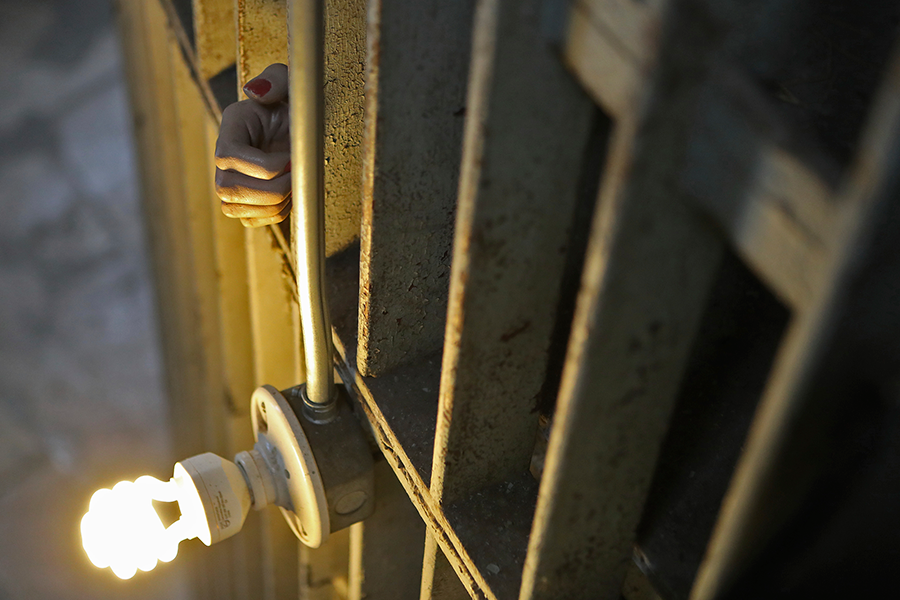Woman gives birth in Detroit jail cell: What are the alternatives to incarceration?
Loading...
When she couldn’t pay the fine for driving on a suspended license, Jessica Preston was sent to jail until her court date. She ended up giving birth there.
This week, Ms. Preston – whose son, Elijha, was born 9 months ago – shared her story with local news outlets. Video of that day shows her asking staff at the Macomb County Jail for medical attention and not receiving it three times over more than eight hours, according to Local 4 Defenders, an investigative news organization that looked into her case. In the end, Preston said, she gave birth on a mat on the dirty jail cell floor.
The county sheriff, Anthony Wickersham, however, told Local 4 that he was “100 percent confident” that staff handled the situation appropriately, and stated that Preston was moved to a medical wing after reporting contractions, according to the AP. He also criticized the low level of funding for medical services, saying that inmates’ care could only be improved if taxpayers were willing to foot the bill.
One of several high-profile medical incidents at that jail alone, Preston’s case echoes a broader national debate about prisoner access to essential health services. There are alternative approaches, advocacy organizations argue. They point to the success of prison-diversion and community programs in relieving the burden on prisons and jails, while improving the standard of prisoner care.
“Studies have long established that women have a lower risk of violence and community harm, thus women are often the ideal prison population for community-based alternative sentencing programs,” wrote advocacy organizations The Rebecca Project for Human Rights and the National Women’s Law Center in a 2010 report, “Women Behind Bars.”
The Eighth Amendment prohibition on cruel and unusual punishment covers the right to medical care for people who are incarcerated, the US Supreme Court has ruled. Yet stories like Preston’s are far from uncommon. In Texas in June 2012, Nicole Guerrero gave birth in a holding cell with no toilet, sink, or emergency call button, after repeatedly requesting assistance from the nurse on duty. Her baby, born with the assistance of a passing guard, was unresponsive and eventually pronounced dead.
Some 3-4 percent of female prisoners enter the system pregnant, a 2004 Bureau of Justice Statistics report found, meaning that thousands of babies are born to imprisoned mothers each year. During a six-month investigation, In These Times spoke with a dozen women who had been pregnant while incarcerated, discovering that many had received no medical attention and most had struggled to get enough to eat.
“Withholding healthy food from a pregnant woman is withholding medical care,” Tess Timoney, a certified nurse-midwife and director of women’s HIV services at New York’s Bronx-Lebanon hospital, told In These Times.
How can these challenges be addressed without placing an additional burden on the taxpayer? The Bangkok Rules, adopted by the UN, which regulate the treatment of women prisoners, may provide a hint. They recommend that “non-custodial measures should be preferred where possible and appropriate” for a pregnant woman or a child’s primary caregiver.
Community-based facilities allow mothers to keep their children with them – and receive appropriate medical care – while remaining under supervision. The Rebecca Project for Human Rights and the National Women’s Law Center argue that these types of programs are not only cheaper than traditional prisons but also achieve better outcomes for both parent and child. A number of states, including Oklahoma and New York, now offer such alternatives.
Participants agree the overall impact of these programs is constructive.
"I honestly wish it wouldn’t ever be over," Diana, from Queens, New York, who was arrested when seven months pregnant, told Life of the Law. "I thought [the program] was just going to be about jail and drugs, but it's not. It's more … learning about yourself and listening to others' stories."
Similar approaches may also help reduce the growing number of people who are locked up for short prison terms over non-violent offenses, possibly stretching prison medical staff and services beyond their capacity. At Macomb County Jail, where Preston was incarcerated, there had been two high-profile cases involving the death of an inmate: Jennifer Meyers in July 2013, and David Stojcevski in June 2014. Both were serving 30-day sentences: Ms. Meyers for failing to pay child support, and Mr. Stojcevski for failing to appear in court over a traffic ticket.
“[Prisons] are not really places that are supposed to be schools, psychiatric hospitals, medical hospitals, childcare facilities. They were not designed to provide all of these services,” Georgia Lerner, the executive director of the Women’s Prison Association in New York, told Life of the Law. “And it’s one of the reasons I don’t think it makes a whole lot of sense to send so many people to prison when there are so many issues that could be better addressed in the community.”
Material from the Associated Press contributed to this report.








